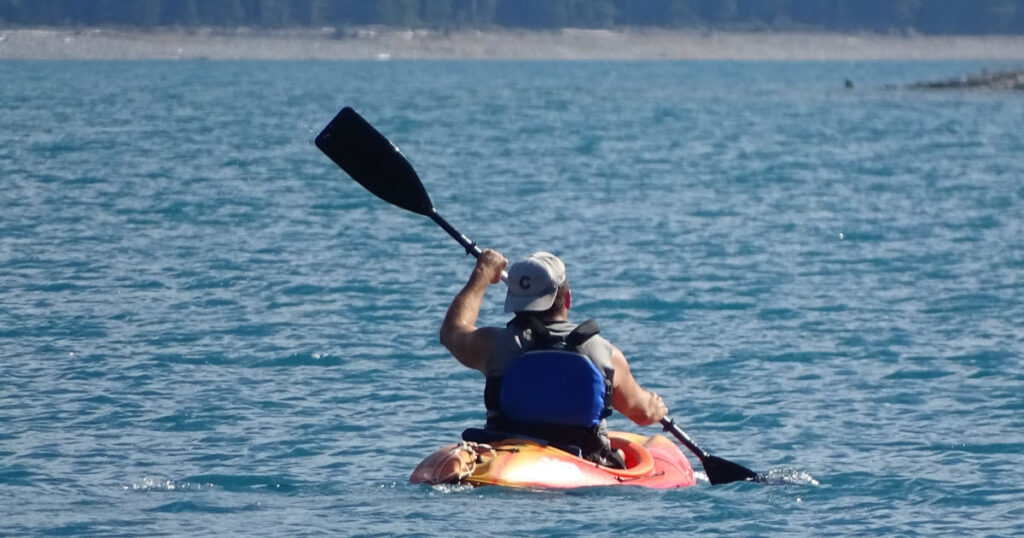If you’ve been thinking of kayaking, but assumed that it would be too hard to learn, think again. The idea that you must be strong or athletic to enjoy this popular sport just isn’t accurate. There are many types of kayaking, and different types of waterways you can explore by Kayak. If you’ve ever wondered: is kayaking hard? I’ll explain what you need to know (and what you can expect) as someone who is new to kayaking.
Kayaking is a Challenge You Can Learn to Love
You will be pleased to learn that there is no reason why you shouldn’t be able to learn how to kayak and enjoy the activity with others.
Success with recreational kayaking doesn’t require any special level of athleticism or strength. In fact, it’s the relaxed self-paced nature of this activity that attracts people of all ages, shapes, and sizes.
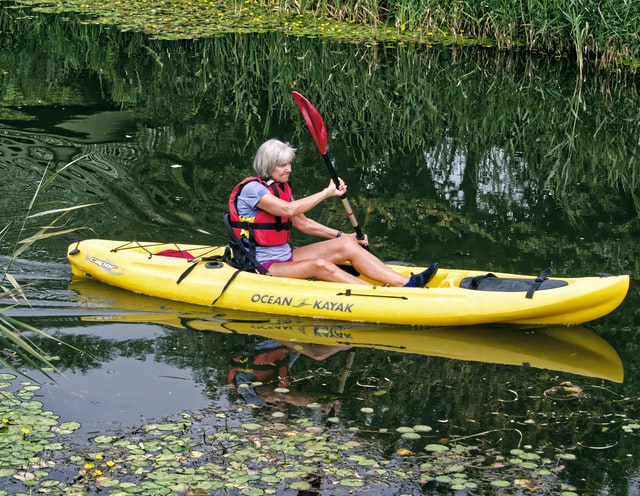
It’s easy to find an instructor who can teach you basic paddling skills and techniques as well as the general knowledge you need to kayak effectively and safely. You will need to learn the forward stroke and the sweep stroke (used for turning direction), as well as general kayak safety before you begin. You can get up to speed on this and other websites, YouTube, or you can take a class from a local company.
When you kayak correctly and use the correct sized paddle, you use the muscles in your core and trunk to make the boat move forward. This means that you won’t need to have extraordinary arm strength, as many people believe.
To propel your crafts forward, you’ll rotate the core of your body and in doing so pull your body in the direction of the paddle.
Should You Be Worried About Your Kayak Tipping Over?
Capsizing is possible with any kind of watercraft. However, as long as you have the correct instruction and proceed mindfully, giving yourself time to learn and progress, there is no reason why you should have any alarming risk of tipping over.
Of course, you should be a proficient swimmer before thinking about going on the water in a kayak. And remember to always wear a personal flotation device (PFD) as well.
When starting out, it’s best to use a kayak that has a high degree of stability.
Most beginners find that a kayak that is a wider size and has a large cockpit is best. This could be a recreational or day touring kayak. With a kayak that has a high level of initial stability (the stability that the boat has when you first get into it), you should be able to stand up without any danger of tipping over.
As a kayaking novice, you should start out on a pond or small lake with tranquil waters. It should be a body of water small enough that you can clearly see each shoreline. Make sure that it doesn’t have any heavy powerboat traffic. This is important because this traffic can cause the water to be more turbulent, and when you’re in a kayak you also risk not being seen by boats moving at a high speed..
Enjoying Scenery While Kayaking
One often overlooked (and my favorite) part of kayaking is how much you’ll enjoy the scenery around you while kayaking. Some novices assume that you’ll be so focused on keeping your craft going straight and navigating in the water that you won’t be free to enjoy your surroundings.
Totally not the case.
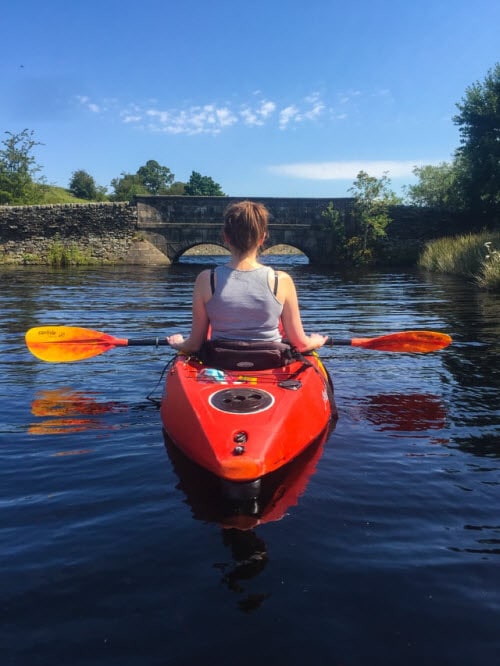
With recreational and day touring kayaks, you should be able to keep your kayak traveling in a straight direction without much effort. And if you want to, get a kayak with a rudder that you can control with foot pedals. It really frees you up to paddle and look around without the need for specialized steering strokes.
Be aware that using the right paddle strokes is key to getting your kayak to go straight, so I do recommend that you practice them during your first trip on the water. You’ll learn them quickly, and once you have these strokes down, in most cases it should be easy for you to look around and enjoy the scenery around you while kayaking.
Start Out With Recreational Kayaking
As a beginner, it’s best to begin with recreational kayaking. With this kind of kayaking (and because you’re just starting out), I recommend that most people consider a sit-on-top kayak. Make sure you get a kayak that is made to have excellent balance and that strongly resists tipping over. You can read my article about some of my favorite brands if you want some guidance about what to get.
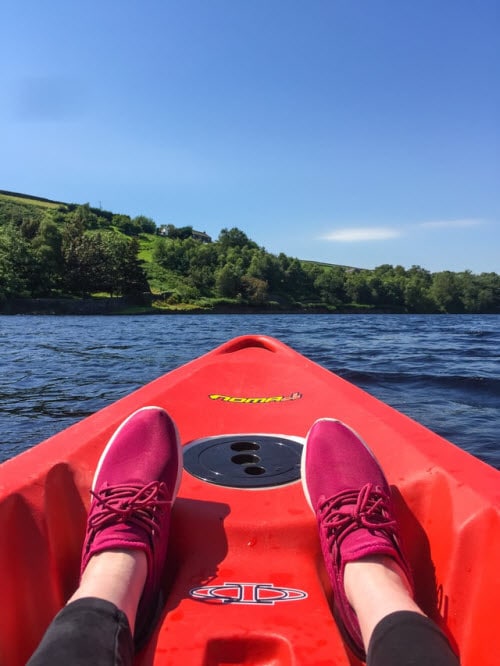
Another advantage of sit-on-top recreational kayaks is that there is often room to store food, phones, and cameras at your feet. With a sit-on-top kayak, it can also be possible to bring children and pets along for the adventure.
Make sure, however, that your kids know how to swim and keep them in their own PFDs. Always start out slow and in very mild conditions, and I recommend getting some practice by yourself before you start piling on pets and kids.
Sit Inside Kayaks are For the More Advanced
Once you get more experienced as a kayaker, you could consider getting a sit-inside kayak and going into more challenging water environments such as oceans or even white water rivers.
Please be aware that these conditions can be dangerous for someone who doesn’t have the necessary experience. Exercise an abundance of caution and never rush into something you’re not absolutely sure that you can handle!
Sit-inside kayaks tip over much more easily than sit-on-top varieties, and they’re more challenging to get back into if you do tip over in open water.
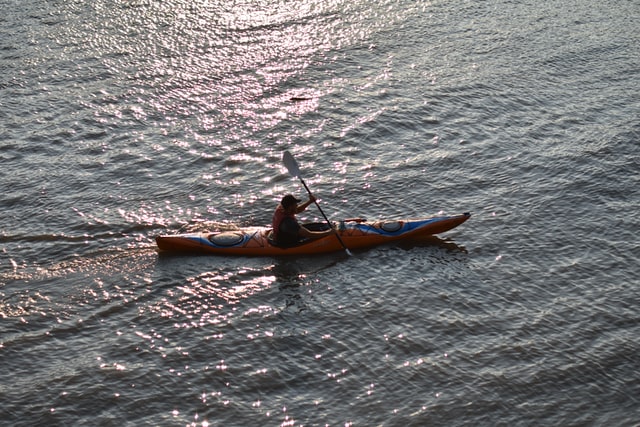
With a sit-inside kayak, however, you get a lot more in the way of maneuverability. With a sit-inside kayak, you will need extra equipment. You’ll want to carry a bilge pump and a paddle float. Prices are very reasonable, and these are necessary in order to roll a capsized kayak back into its upright position.
Getting a sit-inside kayak to return to its upright position can be very challenging if you don’t know the proper technique.
If you ever go kayaking on a white water river or open ocean, then you should know that these types of environments bring special risks.
There is a much higher chance of an accident or situations that call for the knowledge you would gain from years of experience. Some predicaments you could come up against include rocks hidden under white water, unexpected water swell, and a higher risk of your kayak tipping over.
More Advanced Types of Kayaking
It’s only after years of experience kayaking and navigating challenging aquatic environments that you can think about race kayaking or surf kayaking.
Racing kayaks have the thinnest shape of any type of kayak and they tip over extremely easily. Not only that, they are extremely difficult to get into unless you’re experienced (and particularly limber).
White water kayaking is an exhilarating experience, but it’s not something you should try without lots of experience with recreational kayaking and special training from a guide or instructor.
White water kayaking has special dangers, including the dangerous river currents, especially if you or someone you’re with falls out of the kayak. Make sure everyone on the trip has the training they need to keep themselves safe, and wear the proper safety equipment (including a PFD and helmet).
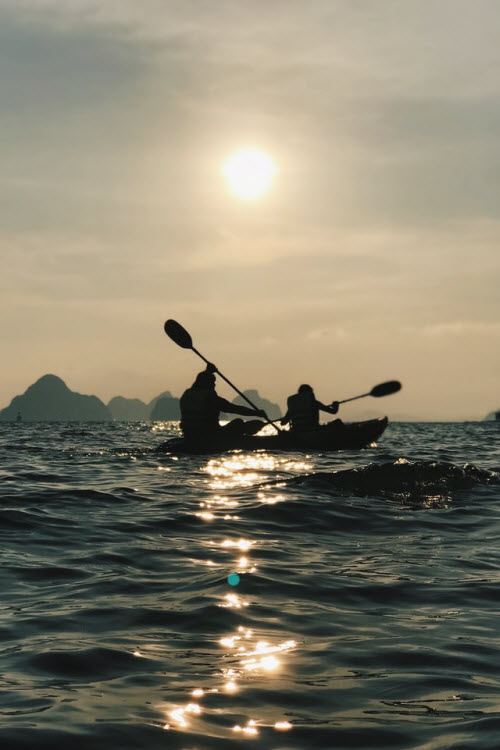
If you ever want to go surf kayaking, you will need to have years of practice in dealing with the ocean and its waves. It can be extremely dangerous if you lack experience. You need to know what you’re doing in the ocean waves.
Benefits of Kayaking
Is Kayaking hard? It can be, but kayaking can have many benefits for your health and fitness (and your soul).
Like other low-impact activities, it can help with your flexibility and strength.
Below are some of the benefits that you can expect to enjoy if you take up kayaking:
- Better muscle strength, especially in the shoulders, back, chest, and arms
- Improved torso strength, as the torso is the main area of the body to power the kayak
- Boosted cardiovascular fitness
As a recreational activity you enjoy in the great outdoors, kayaking also offers emotional and psychological benefits.
Taking part in this activity will create amazing new memories and give you the chance to see beautiful natural landscapes.

